Slow Down! Researchers Spot Possible Speeding 'Renegade' Supermassive Black Hole
Astronomers have spied the possible aftermath of a colossal black hole collision that happened in the center of a galaxy far, far away.
Usually, researchers find supermassive black holes that are stationary objects, anchored in the cores of their galactic hosts. So astronomers became excited when they spotted a "renegade" supermassive black hole speeding through space, as reported in a new study.
The black hole, which is 160 million times the mass of Earth's sun, appears to be the result of a collision with another black hole in a galaxy 3.9 billion light-years away from Earth.
Theory suggests that when two galaxies merge, supermassive black holes in the two galaxies' cores orbit one another and eventually collide. The black hole pair may merge to create an even more massive supermassive black hole. But sometimes, the pair can violently recoil, and one of the black holes may be kicked in the opposite direction at great speed.

The energy behind this powerful recoil is referred to as gravitational waves. As two black holes approach one other, they generate a lot of these ripples in space-time, and if the conditions are right, there might be a preponderance of gravitational waves blasted out in one direction, ejecting one of the black holes.
While searching through thousands of Sloan Digital Sky Survey (SDSS) observations in hopes of finding these recoiling black holes, the new study's researchers noticed a very bright X-ray source at the center of one galaxy. This is a telltale sign that a black hole is active and growing, the researchers said in a statement.
Then, using the Hubble Space Telescope, they discovered that the emissions were coming from two distinct objects. Further observations by NASA's Chandra X-ray Observatory and the Keck telescope in Hawaii revealed that one of the two black holes is not in the center of its galaxy and is traveling at a different speed than its surroundings.
Get the Space.com Newsletter
Breaking space news, the latest updates on rocket launches, skywatching events and more!
These clues suggest the object is a recoiling black hole, and the host galaxy itself also carries evidence of the merger that could have instigated it, the researchers said. The galaxy is forming stars at a high rate, for example, which is a sign that interstellar gases have been compressed. Also, the outer regions of the galaxy show signs of a massive disturbance.
Although the data supports a bona fide recoiling black hole, the researchers said in the statement, further observations are needed to rule out other explanations.
The study was recently accepted to The Astrophysical Journal and is available online on arXiv.org.
Follow Ian O'Neill @astroengine. Follow us @Spacedotcom, Facebook and Google+. Original article on Space.com.
Join our Space Forums to keep talking space on the latest missions, night sky and more! And if you have a news tip, correction or comment, let us know at: community@space.com.
Ian O'Neill is a media relations specialist at NASA's Jet Propulsion Laboratory (JPL) in Southern California. Prior to joining JPL, he served as editor for the Astronomical Society of the Pacific‘s Mercury magazine and Mercury Online and contributed articles to a number of other publications, including Space.com, Space.com, Live Science, HISTORY.com, Scientific American. Ian holds a Ph.D in solar physics and a master's degree in planetary and space physics.









